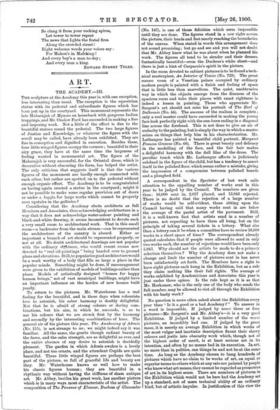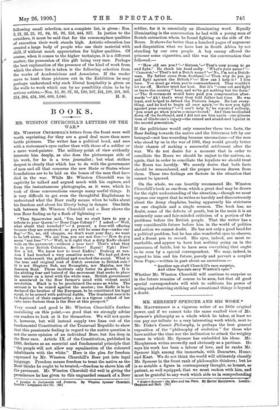ART.
THE ACADEMY.-111.
THE sculpture at the Academy this year is, with one exception, less interesting than usual. The exception is the equestrian statue with its pedestal and subordinate figures which has bpen put up in the courtyard. This monument represents the late Maharajah of Mysore on horseback with gorgeous Indian trappings, and Mr. Onslow Ford has succeeded in making a fine and imposing work. Not a little of the effect is due to the beautiful statues round the pedestal. The two large figures of Justice and Knowledge, or whatever the figure with the scroll may be called, have already been exhibited. They are fine in conception and dignified in execution. Besides these, four little winged figures occupy the corners ; beautiful in their airy grace, they have at the same time the largeness of feeling wanted in monumental art. The figure of the Maharajah is very successful, for the Oriental dress, which is decorative without obscuring the form, has helped the artist. The only criticism that suggests itself is that the various figures of the monument are hardly enough connected with each other, but rather are spotted on to the pedestal without enough organic effect. The Academy is to be congratulated on having again erected a statue in the courtyard ; might it not be possible to make some regular provision out of doors or under a loggia for large works which cannot be properly seen upstairs in the galleries ?
Considering that the Academy elects architects as full Members and Associates, thus acknowledging architecture in a way that it does not acknowledge water-colour painting and black-and-white drawing, it seems inconsistent to devote such a very small room to architectural work. That in this small room—a backwater from the main stream—can be represented the architecture of the country is absurd. Either so important a branch of art should be represented properly, or not at all. No doubt architectural drawings are not popular with the ordinary stghtseer, who would resent rooms now devoted to "real oil-paintings" being handed over to ground plans and elevations. Still, to popularise good architecture would be a work worthy of a body that fills so large a place in the popular minds. Something might be done, if encouragement were given to the exhibition of models of buildings rather than plans. Models of artistically designed "homes for happy human beings," not of vast municipal buildings, might have an important influence on the hordes of new houses built yearly.
To return to the pictures. Mr. Waterhouse has a real feeling for the beautiful, and in these days when colourists love to astonish, his sober harmony is doubly delightful. Not that he is afraid of strong colours or daring com- binations, but his aim, in which he . succeeds, is so to use his colours that we are struck first by the harmony and secondly by the interesting combinations of hues. The general air of his picture this year, The Awakening of Adonis (No. 155), is not strange to us ; we might indeed say it was familiar. All the same, the gentle though radiant beauty of the faces, and the calm strength, are as delightful as ever, and the entire absence of any desire to astonish is decidedly pleasant. The garden in which Adonis awakes is a lovely place, and not too ornate, and the attendant Gupids are quite beautiful. These little winged figures are perhaps the best part of the picture, so full of graceful life and beauty are they. Mr. Waterhouse knows so well how to make his classic figures human ; they are beautiful in a rhythmic way without having the stiffness of sham antique art. Mr. Abbey, besides his great work, has another picture which is in many ways most characteristic of the artist,. The composition of The Penance cl Eleanor, Duchess of Gloucester
(No. 147), is one of those felicities which seem impossible until they are done. The figures stand in a row right across the picture, their heads and feet nearly reaching the boundaries of the canvas. When stated in words this arrangement does not sound promising; but go and see and you will not doubt that Mr. Abbey knew what he was about when he planned his work. The figures all tend to be slender and their dresses fantastically beautiful—even the Duchess's white sheet—and there is just a hint of Carpaccio's spirit in the picture.
In the room devoted to cabinet pictures is to be found a tech- nical masterpiece, An Interior of Venice (No. 729). The great rococo room of a Venetian palace occupied by ordinary modern people is painted with a finish and feeling of space that is little less than marvellous. The quiet, unobtrusive way in which the objects emerge from the dimness of the spacious room and take their places with exact rightness is indeed a lesson in painting. Those who appreciate Mr. Sargent's art should not miss his portrait of The Earl of Dalhousie (No. 44). The success of the realism is complete ; only a real master could have succeeded in making the young face look perfectly right with the sun-burn ending in a diagonal line across the forehead. This is not done to give an air of audacity to the painting, but is simply the way in which a master seizes on things that help him in his characterisation. Mr. Lathangue has painted a beautiful child portrait, Margaret Frances Greaves (No. 68). There is great beauty and delicacy in the modelling of the face, and the fair hair makes a delightful harmony with the dull lilac of the dress. The peculiar touch which Mr. Lathangue affects is judiciously subdued in the figure of the child, but has a tendency to assert itself in the polished floor, which seems rather a mistake, giving the impression of a compromise between polished boards and a ploughed field.
A correspondent in the Spectator of last week calls attention to the appalling number of works sent in this year to be judged by the Council. The numbers are given thus : 16,000 sent in, 2,057 placed, and 13,943 rejected. There is no doubt that the rejection of a large number of works would be self-evident, those sitting upon the Council having said that many works sent in are below the average of the pastel artist of the pavement. Still, it is a well-known fact that artists send in a number of pictures, not expecting to have them all hung, but on the principle of taking several tickets in a lottery. What else than a lottery can it be when a committee have to review 16,000 works in a short space of time P The correspondent already quoted calculates that if people were allowed to send in only two works each, the number of rejections would have been only 5,943. Why should not the artists be made to do a primary selection themselves ? Why the Academy does not make a change and limit the number of pictures sent in has never been satisfactorily set forth. The Members have a right to have eight pictures each hung in the Exhibition, but as a rule they claim nothing like their full rights. The average of works exhibited by Academicians and Associates this year is just under three apiece. Is the rule kept as it is so that Mr. Herkomer, who is the only one of the body who sends the full number, may be allowed to riot all through the Exhibition with his hasty work!
No question is more often asked about the Exhibition every year than " Is it a good or a bad Academy P " To answer in a word is impossible. If judged by some three or four pictures—Mr. Sargent's and Mr. Abbey's—it is a very good Exhibition. If judged by a limited number of the worst pictures, an incredibly bad one. If judged by the great mass, it is merely an average Exhibition in which works of the most vulgar and inartistic description flaunt their showy colours and jostle into obscurity work which, though not of the highest order of merit, is at least serious art in its intention, and often by no means bald in its execution. In. art, no more than in politics, can things be and not be at the .same time. As long as the 'Academy chpose. to hang _hundred& .of pictures which have no claim to be works a art, on .equal_or superior terms to others which at any rate are painted, by people who-know what art means, they cannot be regarded as promoters of art in its highest sense. There are numbers of picture& in the Exhibition which would not be here had the Academy set up a standard, not of mere technical ability of an ordinary kind, but of artistic impulse. In instifiaxtion of this view the
following small selection, not a complete list, is given : Nos. 3, 21, 22, 25, 91, 94, 95, 98, 358, 444, 957. In justice to the outsiders, it must be said that for the commonplace qualities of execution their work stands high. Artistic education has created a large body of people who use their material with skill, if without much appreciation for higher qualities. Of course, when it comes to the higher technique, it is a different matter, the possession of this gift being very rare. Perhaps the best explanation of the presence of the kind of work from which the above list is taken is the following selection from the works of Academicians and Associates. If the reader cares to hunt these pictures out in the Exhibition he may perhaps understand why such liberal hospitality is given on the walls to work which can by no possibility claim to be by serious artists,—Nos. 15, 30, 31, 85, 100, 107, 161, 198, 201, 308,







































 Previous page
Previous page